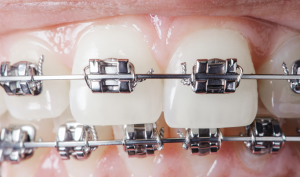 Discomfort caused by orthodontic appliances is never fun. Fortunately, you can fix the discomfort — at least temporarily — without having to come into our office. However, before you start anything on your own, it is important to notify your orthodontist. They may be able to walk you through the process over the phone or via a video call. If given the go-ahead from your orthodontist, you can reference this handy graphic provided by the American Association of Orthodontists (AAO) to help guide you through the steps.
Discomfort caused by orthodontic appliances is never fun. Fortunately, you can fix the discomfort — at least temporarily — without having to come into our office. However, before you start anything on your own, it is important to notify your orthodontist. They may be able to walk you through the process over the phone or via a video call. If given the go-ahead from your orthodontist, you can reference this handy graphic provided by the American Association of Orthodontists (AAO) to help guide you through the steps.
Before starting, however, you should make sure you have a few tools handy:
- Orthodontic relief wax
- Dental floss
- Disinfected tweezers
- Q-tips
- Salt
- Interproximal brush
- Toothpicks
- Non-prescription pain reliever
- Topical anesthetic
The following five orthodontic issues are generally things you can do from home. Remember, though, that it’s always best to contact your orthodontist first before starting out. For more detailed steps, please refer to the image from the AAO.
Lost O-Ring
The disinfected tweezers may be able to help you put a new o-ring in place of one that was lost. Remove any wire ligatures that may come loose with the process; this can be done easily with the tweezers. If the wire ligature isn’t loose but is sticking out, use a Q-tip to bend it back down.
Protruding Wire
Should a wire come loose, use tweezers or a Q-tip to push the wire back so that it is flat against the tooth. In order to help the wire stay in place, take a small amount of relief wax and press it over the wire in question. Make sure your tooth is dry before applying the wax.
Irritation in Mouth
Much like the fix for the protruding wire, a bit of relief wax can go a long way. Get a small piece of wax, roll it into a ball (about the size of a small pea), and press it down over the area of the braces that is causing the irritation.
Discomfort
As your teeth move, you will experience discomfort. This is normal, and should last for a few days, so there is nothing to worry about. However, if you would like some relief for the discomfort, try rinsing your mouth with saltwater or take some pain relievers (be sure to follow the pain reliever’s dosage instructions). If the discomfort lasts for more than a few days, you should contact your orthodontist.
Mouth Sores
Braces do not cause mouth sores. That said, braces can speed up their growth due to irritation caused by the braces. While mouth sores are not serious conditions, they can certainly be annoying. In order to help with the pain and discomfort, use a cotton swab to dab some topical anesthetic over the mouth sore.
While these five orthodontic issues can be at least temporarily fixed at home, don’t forget to consult with your orthodontist. Likewise, if problems persist, that is also a good time to contact your orthodontist. Also, if your braces and/or bands have come even a little bit loose, contact your orthodontist.
Dr. Lamparski and the team at Lamparski Orthodontics is happy to help with any questions you may have. If you have an orthodontic issue, visit us online to find a telephone number for a location near you!


